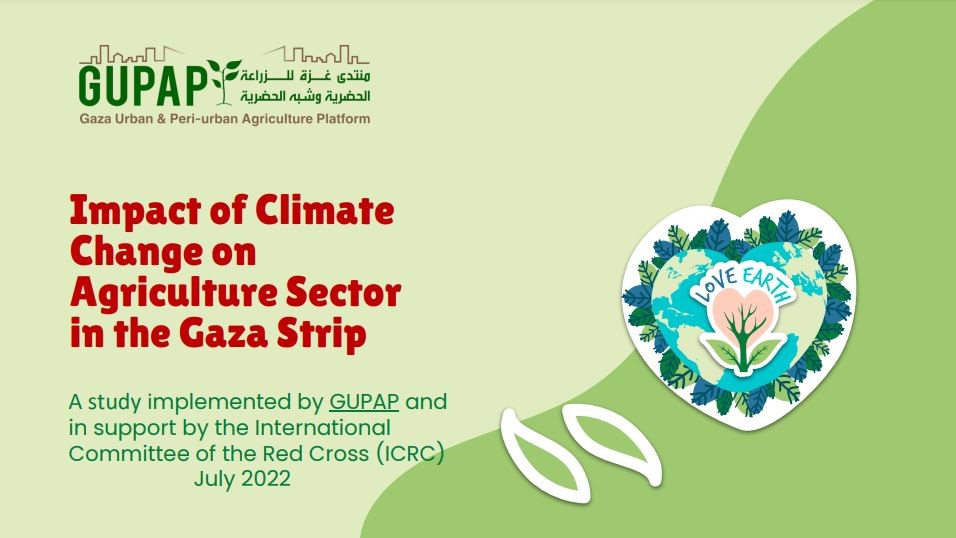The Executive Summary
In February to April 2022, the International Committee of the Red Cross (ICRC) and Gaza Urban & Periurban Agriculture Platform (GUPAP) conducted a study to assess the impacts of climate change on the Gaza farming sector, determine the existing adaptation strategies used by Gaza farmers, identify the enablers for sustainable adaptation action in the field of agriculture, and identify the capacity of the related local authorities, and universities to deal with the climate change challenge.
Methodology: The study team applied mixed methods and a participatory interactive approach using multiple data sources including literature review, 14 interviews, 12 FGDs, and surveys.
Participants: 123 participants from the farmers who participated in the FGDs, 109 out of them filled the survey. 25 farming actors have participated in interview and FGDs.
Main findings:
Finding 1: 95% of surveyed farmers reported that they have been affected by climate change impacts /weather changes during the last year. For example, in 2021, olive and grape production declined significantly, and strong winds blew away almond blossoms and broke some trees. For animal production, the high temperatures caused mortalities in poultry. Little percent (13%) of farmers felt they received support or guidance about this.
Finding 2: Over 85% of the farmers reported that rainfall has declined over the last ten years. 93.6% of the farmers reported that there is an increase in temperatures. Most farmers (104 out of 109) indicated that plant and animal diseases increased such as the peacock eyespot that affects olives due to moisture/humidity and Newcastle disease that spread in poultry in extreme heat. Furthermore, around 94% of surveyed farmers reported that the production costs have increased over the past ten years.
Finding 3: Around 50% or a little more of surveyed farmers indicated that the climate change has highly affected negatively on the scarcity of water resources, the incidence of crop diseases, amount of production, sale of production, the harvesting time and production yields. The highest impact on animal production was noted in the spreading of animal diseases and the reduction of grazing areas by 72.6% and 80.2% of farmers respectively.
Finding 4: Farmers create their own adaptation strategies to adapt to the climate change risks within their financial capacities and apply simple techniques to decrease the negative effects of climate change. However, there are several obstacles that hinder the farmers' ability to face the climate change risks from the farmers' point of view.
For example, the high prices of modern technology devices/ smart farming techniques that can decrease the impact of climate change and it is beyond the capacity of farmers, and the frequent power cuts as farmers indicated in the focus group discussions.
Finding 5: 98% of the farmers follow weather forecasts, and the most commonly used sources to know weather forecasts are media (radio &TV) and social media. Most of them failed to properly define climate and weather, and around 60% of them classify their knowledge about climate changes and its impacts as modest.
Recommendations:
The following recommendations have been proposed by GUPAP as a result of the focus group discussions with the farmers who also gave some practical examples on the next steps.
Recommendation 1: Find new and effective ways to engage with the farmers and raise their awareness about climate change impacts. For example, a website or a mobile phone app could be created to showcase awareness-raising, outreach activities and provide accurate predictions of weather conditions and technical advice to farmers.
Recommendation 2: Support smart agricultural solutions that enable climate adaptation. For example, authorities with support of the international community could look-into schemes to compensate farmers and create climate-friendly adaptation solutions.
Recommendation 3: Create a community of concern among local stakeholders, farmers committees, Environmental Quality Authority, NGOs, municipalities, and Gaza Ministry of Agriculture to identify innovative solutions to adapt to climate change.
Recommendation 4: Improve the capacity of farmers, agencies and academia to utilize the online Israeli metrological services capturing data close geographically to the Palestinian cities (13-15 km distance). A technical working group between the Israeli metrological service and Gaza counterparts could be organized.
Recommendation 5: Carry out an in-depth research on climate change impacts in Gaza, in order to understand the scenarios and set the required adaptation strategies.
You may read full study here [LINK]



